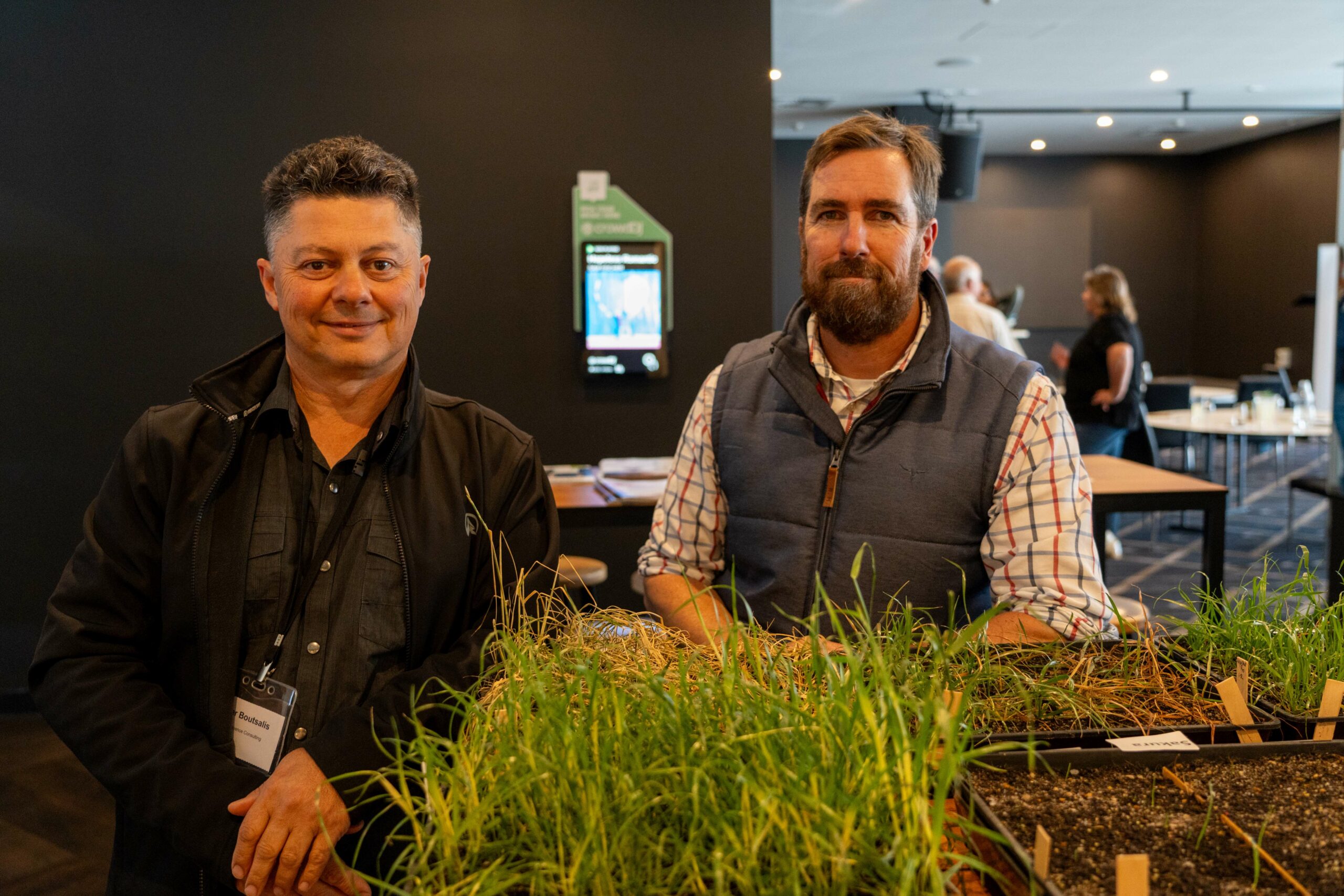Managing herbicide resistance in onions
The list of available herbicides that can be used within onion crops is limited, and with herbicide resistance increasing in ryegrass, control of the weed is challenging for growers.
The Onion Lunch held late 2023, was an opportunity to showcase to onion growers the widespread herbicide resistant ryegrass issues and how herbicide resistance can be managed.
Presented by Dr Peter Boutsalis and Dr Sam Kleemann of Plant Science Consulting, the presentation focused on pot samples showing the efficacy – and sometimes lack of – herbicides on ryegrass.
Annual ryegrass is the most problematic weed for the broadacre sector, and many of the management learnings can be drawn from that industry.
Herbicides are classified on how they kill plants – the mode of action. The most common mode of action herbicide group used to control ryegrass is the ACC Inhibitors (Group 1) class of herbicides. ACC herbicides target an enzyme in the plant (ACCase for short), with these herbicides divided into two chemical classes, abbreviated to FOPs and DIMs. Cross resistance to multiple chemistries (herbicides) within ACC herbicides is common in ryegrass.
“Ryegrass has a huge level of resistance to several different modes of action,” said Sam.
“There are a couple of reasons why. Firstly, ryegrass is an obligate out-crosser, which means it is pollinated by its neighbour. If the neighbour carries resistance, the next generation will also be resistant.
“Annual ryegrass has been planted for decades for livestock production, which means it is spread across the country and has a huge genetic diversity, which in turn means that the chances of mutation or resistance mechanisms being present is quite high.”
As a highly competitive grass, ryegrass will compete strongly against onion crops, and can produce thousands of seeds. Crop rotation is recommended between 5-7 years between onion crops. Fortunately, ryegrass has a relatively short seed bank duration of around three years.
With appropriate management between onion crops, ryegrass pressure can be significantly reduced by running down the ryegrass seed bank to a manageable level.
“Initial studies identified that 1: 500,000 plants within a susceptible ryegrass population can contain a herbicide resistant ACCase mutation conferring resistance to a Group 1 FOP herbicide such as Fusilade. Repeated use of a Group A herbicide can rapidly enrich resistant plants making the whole field is resistant.”
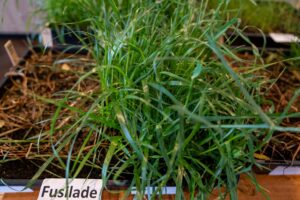
“Comparing treated [ryegrass] with untreated [ryegrass] using Fusilade, a Group 1 herbicide, it can work effectively, however experience from the broadacre guys, says that over reliance on Fusilade means it has lost its efficacy.” (Figure 1)
Products such as Fusilade target specific enzymes to inhibit plant growth. A resistant ACCase enzyme can render Fusilade ineffective. Increasing the spray rate rarely results in any additional control.
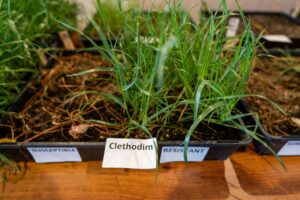
Random weed surveys funded by the GRDC in all the southern states have detected ryegrass highly resistant to the FOP herbicides. Small pockets of the Mallee are still able to use this Group, but it is likely that these herbicides have not been used extensively in the region.
The temptation to increase the rate of Group 1 herbicides could be deemed as a way to improve control but this is rare and usually results in no additional control and increases the risk of damaging the onion crop.
In broadacre, the shift from FOPs to DIMs has created a situation where resistance is now occurring at a high level and the industry is running out of options to control ryegrass. (Figure 2)
Planning to control ryegrass
The recommendation for rotation of onions is 5-7 years. Taking advantage of this window says Sam, holds a key to getting ryegrass under control, by knocking down the ryegrass seed bank.
Using herbicides that are still effective on ryegrass, away from an onion crop will minimise the weed pressure and selection pressure on Group 1 herbicides.
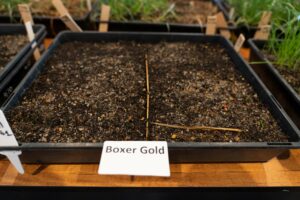
“A good tactic to employ that is promising in the broadacre space is the use of residual pre-emergent herbicides, such as Boxer Gold and Sakura,” says Sam.
“You can see in the pot trial that Boxer Gold is extremely effective and can be a useful option in cereals such as wheat and barley. (Figure 3)
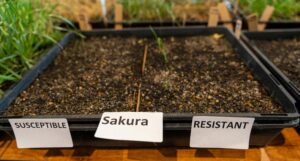
“Under a centre pivot, the herbicide can be washed to give effective control. Sakura is another herbicide that is also proving to be effective pre-emergent tactic.” (Figure 4)
According to Sam, other herbicides that can also be used to tackle Group 1 and 2 resistant ryegrass include Mateno Complete, Luximax, Overwatch and Ultro.
Efficacy in the use of residual herbicides relies on solubility to reach the seed bank. Turning the soil to plant onions, means that the seed bank is distributed through a much greater soil layer, such that residual herbicides may not reach the ryegrass seeds. Ryegrass seeds nearer to the surface may incur the full potency of the herbicide, however, seeds as deep as 10cm, will have an opportunity to develop resistance. This is where an effective post emergent herbicide is required to control the ryegrass once it has germinated; this is the missing link- the lack of effective crop selective post-emergent herbicides. Rotating between the many pre-emergent herbicides will help avoid the development of resistance to any one pre-emergent herbicides.
Glyphosate and paraquat on the edge
Testing by Peter and Sam has shown that glyphosate resistance is on the rise with 16% of paddocks surveyed in 2020 containing glyphosate resistant ryegrass. Often glyphosate resistant ryegrass is affected, but eventually reshoots.
“Ryegrass surviving a field application of glyphosate is not always due to resistance. Often other factors such as growth stage, stressed weeds, application and even poor quality glyphosate products can affect control. The only way to be certain is to have the weeds tested by a lab. Often, increasing the rate can provide complete control.”
In broadacre a move away from glyphosate to paraquat for ryegrass control has produced the odd case of resistance to paraquat (and often cross resistance to glyphosate too). Resistance to both is a significant issue due to the lack of alternative knockdown herbicides (Figure 5 & 6).
“For onions, we would recommend a strong knock-down strategy (glyphosate followed by paraquat within five days) just prior sowing an onion crop.
“With so many chemistries not available in the onion space, it would be more effective to utilise these alternative mode of action herbicides in competitive rotational crops to significantly reduce the ryegrass seed bank.”
“It is also important to identify any resistance that is expressed in your ryegrass – ryegrass testing is the only way that this can be done with any certainty. Knowing what resistance is present – or not, will give you a clearer idea of what you can and can’t use.”
“Plant Science Consulting provides a service to test for ryegrass seeds or plants growing in the field, with more information found at plantscienceconsulting.com.au”


